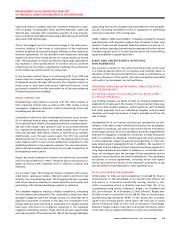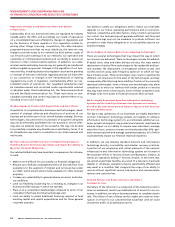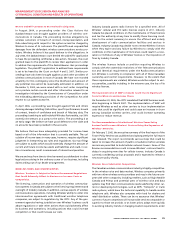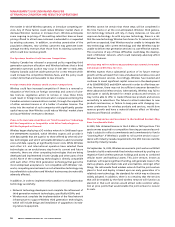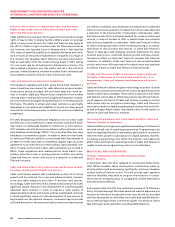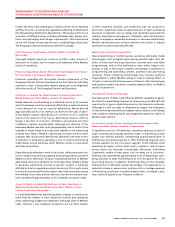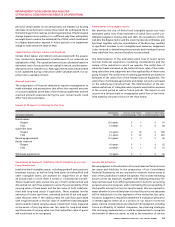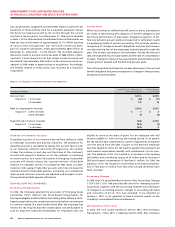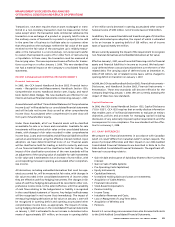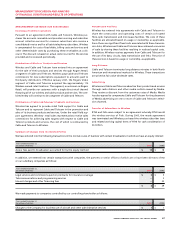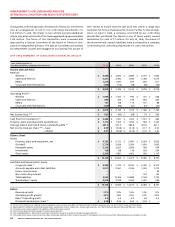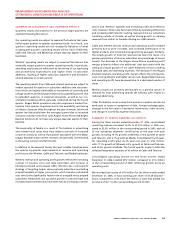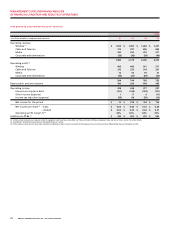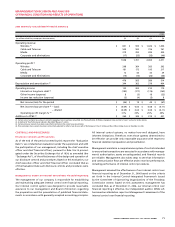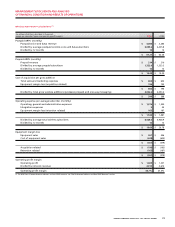Rogers 2006 Annual Report Download - page 67
Download and view the complete annual report
Please find page 67 of the 2006 Rogers annual report below. You can navigate through the pages in the report by either clicking on the pages listed below, or by using the keyword search tool below to find specific information within the annual report.
63
RO GER S CO MMU NIC AT ION S IN C . 20 0 6 ANN UA L RE POR T
MANAGEMENT’S DISCUSSION AND ANALYSIS
OF FINANCIAL CONDITION AND RESULTS OF OPERATIONS
period of certain assets. On an annual basis, we reassess our existing
estimates of useful lives to ensure they match the anticipated life of
the technology from a revenue-producing perspective. If technological
change happens more quickly or in a different way than anticipated,
we might have to reduce the estimated life of PP&E, which could result
in a higher depreciation expense in future periods or an impairment
charge to write down the value of PP&E.
Capitalization of Direct Labour and Overhead
Certain direct labour and indirect costs associated with the acquisi-
tion, construction, development or betterment of our networks are
capitalized to PP&E. The capitalized amounts are calculated based on
estimated costs of projects that are capital in nature, and are gener-
ally based on the rate per hour. Although interest costs are permitted
to be capitalized during construction under Canadian GAAP, it is our
policy not to capitalize interest.
Accrued Liabilities
The preparation of financial statements requires management to
make estimates and assumptions that affect the reported amounts
of accrued liabilities at the date of the financial statements and the
reported amounts expensed during the year. Actual results could
differ from those estimates.
Amor tization of Intangible Asset s
We amortize the cost of finite-lived intangible assets over their
estimated useful lives. These estimates of useful lives involve con-
siderable judgment. During 2004 and 2005, the acquisitions of Fido,
Call-Net, the Rogers Centre and the minority interests in Wireless and
Sportsnet together with the consolidation of the Blue Jays, resulted
in significant increases to our intangible asset balances. Judgement
is also involved in determining that spectrum and broadcast licences
have indefinite lives, and are therefore not amortized.
The determination of the estimated useful lives of brand names
involves historical experience, marketing considerations and the
nature of the industries in which we operate. The useful lives of
subscriber bases are based on the historical churn rates of the under-
lying subscribers and judgments as to the applicability of these rates
going forward. The useful lives of roaming agreements are based on
estimates of the useful lives of the related network equipment. The
useful lives of wholesale agreements and dealer networks are based
on the underlying contractual lives. The determination of the esti-
mated useful lives of intangible assets impacts amortization expense
in the current period as well as future periods. The impact on net
income on a full-year basis of changing the useful lives of the finite-
lived assets by one year is shown in the chart below.
Impact of Changes in Estimated Useful Lives
Amortization Increase in Net Income Decrease in Net Income
(In millions of dollars) Period if Life Increased by 1 Year if Life Decreased by 1 Year
Brand names
Rogers 20.0 years $ 1 $ (1)
Fido 5.0 years $ 3 $ (5)
Subscriber base
Rogers 4.6 years $ 30 $ (54)
Fido 2.3 years $ 23 $ (61)
Roaming agreements 12.0 years $ 3 $ (4)
Dealer network
Rogers 4.0 years $ 1 $ (2)
Fido 4.0 years $ 1 $ (1)
Wholesale agreements 3.2 years $ 1 $ (2)
Impairment of Goodwill, Indefinite -Lived Intangible Assets and
Long - Lived Assets
Indefinite-lived intangible assets, including goodwill and spectrum/
broadcast licences, as well as long-lived assets including PP&E and
other intangible assets, are assessed for impairment on at least
an annual basis or more often if events or circumstances warrant.
These impairment tests involve the use of both undiscounted and
discounted net cash flow analyses to assess the recoverability of the
carrying value of these assets and the fair value of both indefinite-
lived and long-lived assets if applicable. These analyses involve
estimates of future cash flows, estimated periods of use and appli-
cable discount rates. If the undiscounted net cash flows associated
with long-lived assets or the fair value of indefinite-lived intangible
assets exceeds related carrying values, impairment losses measured
as the excess of carrying value over fair value for long-lived assets
and the excess of carrying value over the implied fair value of good-
will would have to be recognized.
Income Tax Estimates
We use judgment in the estimation of income taxes and future income
tax assets and liabilities. In the preparation of our Consolidated
Financial Statements, we are required to estimate income taxes in
each of the jurisdictions in which we operate. This involves estimating
actual current tax exposure, together with assessing temporary dif-
ferences that result from differing treatments in items for accounting
purposes versus tax purposes, and in estimating the recoverability of
the benefits arising from tax loss carryforwards. We are required to
assess whether it is more likely than not that future income tax assets
will be realized prior to the expiration of the related tax loss carry-
forwards. Judgment is required to determine if a valuation allowance
is needed against either all or a portion of our future income tax
assets. Various considerations are reflected in this judgment including
future profitability of related companies, tax planning strategies
that are being implemented or could be implemented to recognize
the benefits of these tax assets, as well as the expiration of the tax


